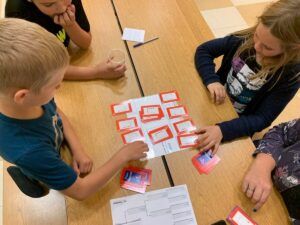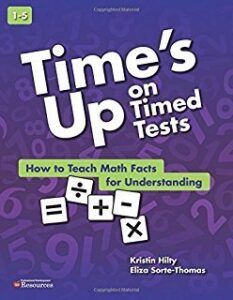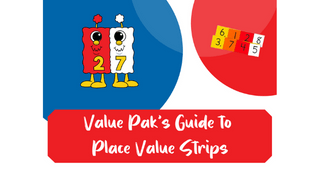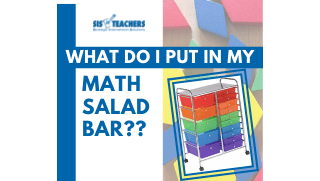The importance of multiplication patterns is a topic that we’ve covered before at SIS4Teachers, but is no less important now than it was then.

As we are out working in schools, we’ve unfortunately observed that students coming into third grade and then going on to fourth and fifth are not getting any better at understanding their multiplication facts. Faster isn’t smarter, as we’ve said before, and what kids today are lacking is the understanding of and the ability to apply multiplication patterns.
For more of the research on timed tests and fact fluency, you can find some great articles by Dr. Jo Boaler at YouCubed on our Math Resources page.
To help address this challenge and help kids really understand multiplication and division, we’ve been implementing our multiplication journals and using our number bond cards with our project schools. Kids seem to be able to come up with great games to play, like Bump! But, one of the things we’ve been working on figuring out is a way to help students increase their speed of understanding for patterns.
Discovering the Need…for Speed!
 This summer, I was in Las Vegas presenting at the SDE conference. (Side note: if you’ve never been, mark your calendar for next summer. You won’t want to miss this conference and you’ll definitely thank me later!). One of my colleagues, Sherry Salone, came up to me after one of my presentations and said, “You HAVE to come down with me to one of the vendor booths because I HAVE to show you this math game.” Being in the middle of presenting at a huge conference that gets a little bit crazy with all the different sessions, I thought, “I don’t have time for that!” But Sherry was persistent and convinced me to come on a quick break because she said I HAD to see this lady who had this awesome multiplication game called Speed!
This summer, I was in Las Vegas presenting at the SDE conference. (Side note: if you’ve never been, mark your calendar for next summer. You won’t want to miss this conference and you’ll definitely thank me later!). One of my colleagues, Sherry Salone, came up to me after one of my presentations and said, “You HAVE to come down with me to one of the vendor booths because I HAVE to show you this math game.” Being in the middle of presenting at a huge conference that gets a little bit crazy with all the different sessions, I thought, “I don’t have time for that!” But Sherry was persistent and convinced me to come on a quick break because she said I HAD to see this lady who had this awesome multiplication game called Speed!
I walked up to the booth and met the lady I now know as Julie from Highhill Homeschool and she showed me how to play her game. I don’t know about you, but I used to play Speed all the time when I was a kid and I LOVED it! I remember always trying to beat my brother and sister! We played with a regular deck of cards and we would go up or down in numerical order as quickly as possible until all of our cards were out – for example, if there was a 10, I’d put down either a 9 or a jack.
Julie played the game with me at her booth and talked with me about the different types of multiplication games that she had. There’s a different deck of Speed! cards for the 2s through 9s (you don’t need a Ten Speed! or a One Speed!). The box comes in numerical order, but the first thing that popped into my mind was that we have a specific, succinct order of teaching the multiplication facts to help combat the struggle we have with helping kids understand the patterns. If we go in numerical order, the 2s, 3s, and 4s are pretty simple to memorize and we always feel like things are going well as students sail through those facts. And when we get to 5s, that’s even better! But when they get to 6s, 7s, and 8s, students fall off the wagon and fluency gets left behind, despite our best efforts.

Although I didn’t do this in front of her, I really wanted to reorder the box the way you see here, which is the way I show it at my trainings. I start with the 5s, at the top, because 5s and 10s are easily taught. Then, I group the 2s, 4s and 8s, then the 3s, 6s, and 9s, and then we teach the 7s as a stand alone. This mirrors how we teach multiplication in our multiplication journal, as well as the book Time’s Up on Timed Tests.
As we played, I found out that Julie a homeschool teacher and, as she was teaching her children, she also saw the need for kids to really understand the patterns behind multiplication. Ironically, Julie is from South Haven, Michigan, but it took both of us going to Las Vegas to get connected! But I’m so glad we did!
How it Works
https://www.facebook.com/StrategicInterventionSolutions/videos/1183527001841486/
One of the unique features of the cards is the beaded pattern they use to show you the groups of the number on your deck. For example, in the 3s deck, if you were looking at the number 18, you’d be able to see how many groups of 3 are in 18 by counting the number of sets of 3 that are filled in. Julie pointed out that this features means that you can also use the Speed! Card game as a tool for division. You simply hold up the card and ask the student to identify the number of groups in a particular number.
Kids can also lay out the cards and simply group them by pattern. If I were to lay out the cards for the 2s Speed! deck – 2, 4, 6, 8, 10, 12 all the way up to 20 – then lay out the cards for the 4s deck on top, I could easily see where the two sequences overlapped, which was at 4, 8, 12 and so forth. Then I’d lay the 8 Speed! on top of it so kids could see what patterns were forming. To help solidify this perspective, students could take this concept and talk in their multiplication journals about the kinds of patterns they noticed, or connect it to the page in the journal that highlights the pattern.
Speed! was so fun, so fast-paced. Of course, I purchased two of them and told Julie I really wanted this game to be in our project schools we are working on in our M³ classes to fit right along with our multiplication journals and the research that we’ve looked at in multiplication. We’re super excited to be able to be in a partnership with Highhill Education so that we can now have the game in our store and get her product in our schools. We recommend that each of our classrooms have three sets of the Speed! card game in our 3rd grade classrooms. That way, while you’re working on the patterns of 2s, 3s, and 4s, kids could pull out the decks (you’d have three of each number) and you could have six kids play at a time in the workshop.
Parent Night
 We were able to feature this game at a recent parent night that we hosted in Coopersville Public School. It was such a great opportunity to get tools into the hands of parents that will benefit students, but are easy, fast, and fun. About 60 families attended and we got a chance to talk to them a little bit about the strategies we’re using in the classroom and the importance of those strategies for their kids’ success. We used some of their title funding, and so, at the end, and we were able to get every family a set of the Speed! game to take home.
We were able to feature this game at a recent parent night that we hosted in Coopersville Public School. It was such a great opportunity to get tools into the hands of parents that will benefit students, but are easy, fast, and fun. About 60 families attended and we got a chance to talk to them a little bit about the strategies we’re using in the classroom and the importance of those strategies for their kids’ success. We used some of their title funding, and so, at the end, and we were able to get every family a set of the Speed! game to take home.

Originally, we were just going to give the game to upper elementary students since that’s where we work on multiplication. However, I was reminded that Kindergartners can skip count by 2s and 5s, so they got the game too! For parents using the game at home, I create a game board for the Speed! game to give them a bit more direction for setting up and playing the game, put it into a clear plastic sleeve and sent one home with each family. Some kids also need the game boards to help them stay accountable during our math workshop.
I also created a tournament for my Speed! players which was sort of like the Elite Eight (Yes, I know that during actual March Madness, you actually have to win games to get to the Elite Eight). Groups of eight friends (mom, dad, brother, sister, classmates, etc.) got together, selected the deck of Speed! cards they wanted to use, and played to see who was the master champion by being the master pattern maker.
Patterns before Fluency
I’m absolutely in love with this game. It’s not often I find a product that fits right into the strategies that I’m working on with teachers that is also something kids can get super excited about. Ultimately, multiplication is not just about skip counting forwards and backwards, but understanding the patterns that are happening within it. So, whether you’re skip counting on an abacus (forward and backwards by four to 40, for example), or tossing a koosh ball back and forth and having kids skip count forward and backwards by a certain number, or playing the game Speed!, or playing a Bump! game, or pulling out the number bond cards – the kids can see and make connections with the patterns instead of memorizing things that are flashed in front of them.
 While some of our kids thrive on and love to do fact practice, I’d bet that a large majority of our kids don’t. And so, giving timed tests over and over again certainly isn’t the answer to increase fluency. We have to look to the pattern, and then eventually they will develop fluency. That’s why Time’s Up on Timed Tests, a book by two of my really great presenter friends – Eliza Sorte-Thomas & Kristin Hilty – is an amazing book. It’s filled with all kinds of strategies, games and activities that help kids become fluent with their grade levels fact fluency expectations.
While some of our kids thrive on and love to do fact practice, I’d bet that a large majority of our kids don’t. And so, giving timed tests over and over again certainly isn’t the answer to increase fluency. We have to look to the pattern, and then eventually they will develop fluency. That’s why Time’s Up on Timed Tests, a book by two of my really great presenter friends – Eliza Sorte-Thomas & Kristin Hilty – is an amazing book. It’s filled with all kinds of strategies, games and activities that help kids become fluent with their grade levels fact fluency expectations.
I hope you enjoy the game of Speed!
Let us know if you’re interested in doing a parent night at your school – we can get you some great deals on this amazing game!
Check out the bundle deal in our store – buy 3 sets of the game for your classroom and get a discount!
Also, you can download the game board and the elite eight tournament bracket by clicking the images below, or download the PDFs when you purchase the game!








